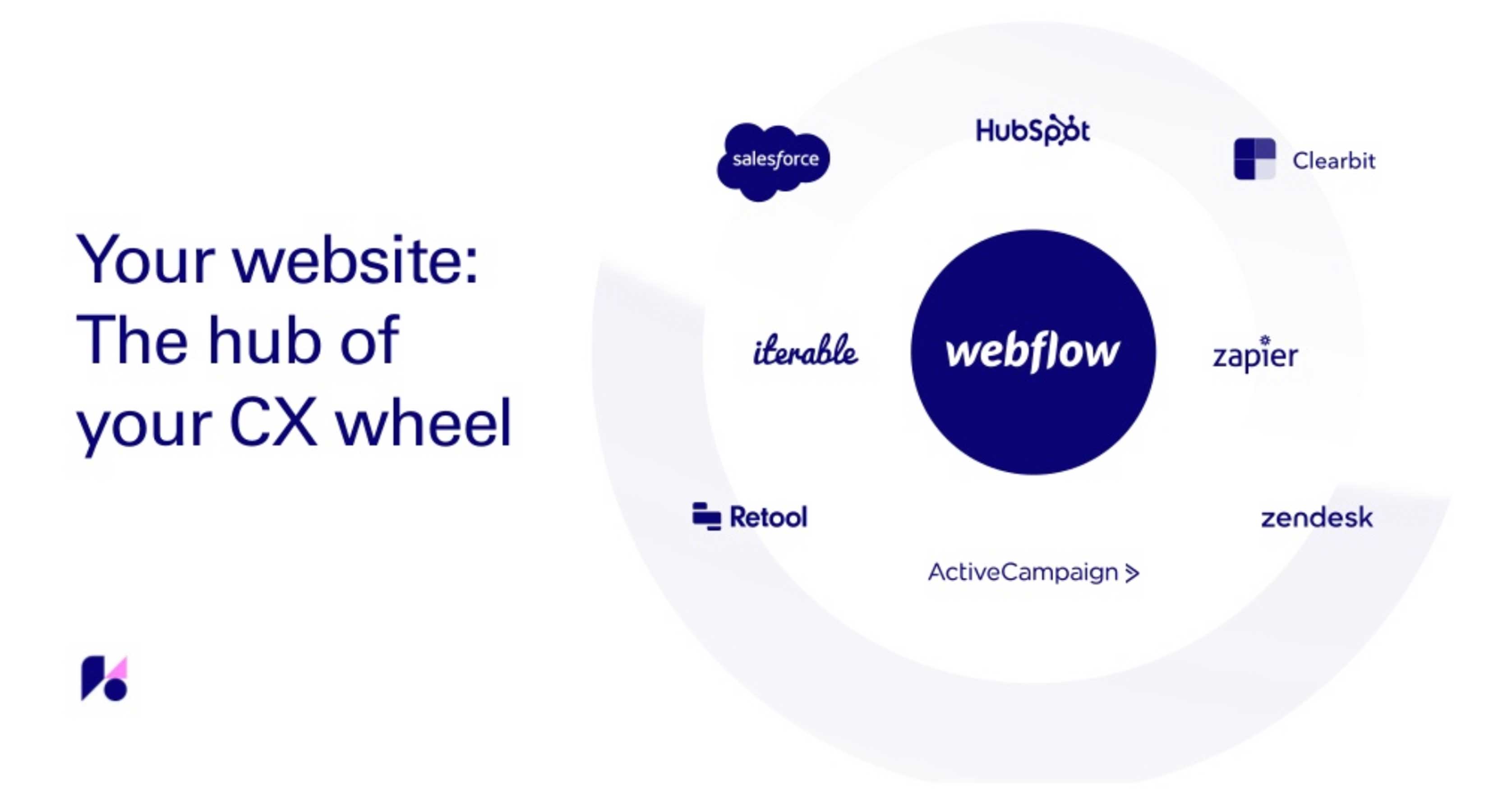No code means putting your budget on building memorable customer experiences, rather than focusing heavily on infrastructure.
Bryant Chou, CTO and cofounder of Webflow, spoke at No Code Conf about where things are headed and how this liberation from managing the backend will change how brands connect with their audience.
In 2009, Chou was a junior engineer working at Intuit. His job effectively came to a standstill as the company went into a state of reorganizational limbo. During this idle time, he set out to create an app based on cutting-edge technology for the time — Android 1.5.
Inspired by his childhood love of chatting with his friend on walkie-talkies, he decided to create an app based on this immediate two-way communication. After diving in and learning the ins and outs of building an app on Android 1.5, Chou finished it and aptly titled it Hoot. With a simple interface of one red button, you could record and zap out a message to anyone on your contact list.
Chou put out this app for free and gained quite a bit of traction, cracking the top ten of trending free apps in the Google Play Store — reaching 10,000 downloads in a month. Naturally, he was excited about creating a viral hit app — that is, until he received a bill from Amazon Web Services. His feelings of elation over the app taking off were crushed when he learned he owed $300 for the infrastructure that made it possible.
“I could either spend a lot of time on this app making it better because it was so raw and had a ton of bugs, or I had to scale this server to make it more performant. And essentially I had a tough call to actually shut it down.” — Bryant Chou
He made the hard decision and pulled the plug on Hoot.
Follow along with presentation slides
Follow along by checking the presentation slides from this talk:
Prefer to watch?
We've got you. Check out Bryant Chou's full talk at No Code Conf 2019:
Infrastructure used to be complicated
Just 10 years ago, you had to know how to scale databases if you wanted to run a popular website or app. And if you didn't, you had to hire someone who did. Keeping things updated and running smoothly required continuous effort, taking up a lot of time.
Today, you don’t have to concern yourself with what happens in the backend. Webflow takes care of security, maintenance, and scalability to keep things running so you can focus on what’s important — the customer experience.
Webflow means protection
There are so many bad actors out there ruining the internet. Webflow keeps you protected from a wide array of threats that WordPress is especially susceptible to, including:
- Brute force attacks
- SQL injection
- Malware
- Cross-site scripting
- DDoS attacks
- Vulnerabilities from outdated versions of WordPress or PHP versions
Webflow also does regular penetration testing, which is a controlled way to execute a fake cyberattack to see how security measures are holding up. Being liberated from dealing with these things on the backend gives you more time to put effort into other areas.
“Makers can build the best possible products and work on things that actually matter like marketing, growth, leveraging the data that you’re collecting, as well as automation.” — Bryant Chou

Webflow makes scalability automatic
Webflow’s network of websites receive over 2 billion views a month. Let that sink in. That's a lot of page views. Some web hosting providers would get bogged down with this colossal amount of traffic — or worse, go offline. But because Webflow’s hosting speeds are like a bullet train, loading times are extremely fast and they can easily scale up to accommodate surges of traffic.

Webflow uses modern technologies for absolute scalability, including:
- Amazon Web Services and their DDoS protection layer shield
- NLB Global Accelerator for load balancing
- Kubernetes to manage the server side
- Amazon S3 for data storage
- The database service DynamoDB
- A specialized version of NGINX that powers 10% of the internet
“It doesn’t make sense running your own marketing site, company blog, or ecommerce store anymore when the intricacies are taken care of by Webflow.” — Bryant Chou
How does Webflow do it? Webflow spends $125,000 a month managing, maintaining, and updating its infrastructure, and has a team of engineers and experts staying on top of things. And it works. With 99.999% uptime and an average page load time of 400 ms, it’s stable and quick.
The no code movement lifts the weight of having to deal with software, servers, and other technical aspects of running a website. It lets you focus on putting effort into marketing and other avenues of growing your brand.



















What to look for in a web hosting service
There are tons of web hosting options out there — but how do you know what features to look for? See how Webflow Hosting could be the perfect fit.
No code frees you to market better
"As a late millennial myself, we’re not necessarily a generation who responds to sales well.” — Bryant Chou
The marketing landscape has changed, and to reach this younger generation brands need to build more than a digital platform of bland self-promotion. They need to put something on the web that has depth. To connect with this younger demographic, and to provide a better experience for everyone, the focus needs to be on the customer. When you don't have to worry about code or what's running the backend, you can give customers an optimal customer experience.
Customer experience supercharges traditional marketing and brings momentum with greater sales and growth of repeatable product lead growth. Products, along with data and automation, are the fuel that drives stellar customer experience.
How customer experience will transform the future
“A renewed focus on customer experience that involves growth, product, and marketing can really empower modern-day sales and marketing motions so that we can actually build companies through product lead growth.” — Bryant Chou
Customer experience marketers' expertise encompasses product, content, and growth marketing. They know their audience and work with marketing teams to develop a content strategy and deliver content that their audience will find valuable. They collaborate with visual developers — another important role in customer experience — to craft this content.
The customer experience stack
The customer experience stack makes it possible to offer an individualized and consistent experience for each person navigating through a brand’s digital space. Data shapes what they see, and how they interact. Each layer of the customer experience stack comes together in fostering more personal connections with a brand’s audience.

Personalization and AI
This evolution of marketing requires a new approach to the customer experience stack. Personalization and AI occupy the top tier of this reimagined customer experience stack. User attributes and data are gathered and integrated into different applications, like Clearbit or MonkeyLearn, so each person using a website has a personalized experience.
Experience and commerce
Experience and commerce occupies the next level down the customer experience stack. This is where a brand gets the chance to make a good impression and where an audience can interact and buy things from them.
Life cycle
The type of messaging, when it’s delivered, and the channels that deliver it matter in making sure that customers get the right information when they need it. Tools like Zendesk for customer service, Iterable for engaging across different platforms, and ActiveCampaign for marketing automation can help facilitate this communication.
Data
This level of the customer experience stack involves data — both where it’s kept and how it can be accessed. Tools like Segment, which catches data and transports it to other software, or Snowflake, which compresses down and structures data, are helpful in managing data.
Automation
This level of the stack mechanizes all of the personalized data and transmits it to tools like Parabola, Retool, and Zapier, where data can be analyzed and utilized.
Customer experience is multifaceted
“That’s what, in my opinion, is the exciting thing about customer experience in the future: where you’re really thinking about customer experience from a holistic standpoint and using the best-in-class tools to provide it.” — Bryant Chou
A website is the focal point in a brand’s circle of marketing. The information and data a customer shares gets shuttled off to connected platforms like Zapier, HubSpot, and Salesforce, further enhancing the customer experience and helping a brand better serve their customers.

No code ushers in a new decade of customer experience
No code isn’t meant to sleight those who have the expertise and passion for all that is data, servers, and infrastructure. Webflow depends on these noble tech geeks to keep things running for the thousands of websites that it hosts.
Why worry about these things when you don’t have to? Keep things simple so you can jump on the swelling wave that is customer experience and build a better brand.
Let us know in the comments below how you're using no code tools to create better customer experiences!






























